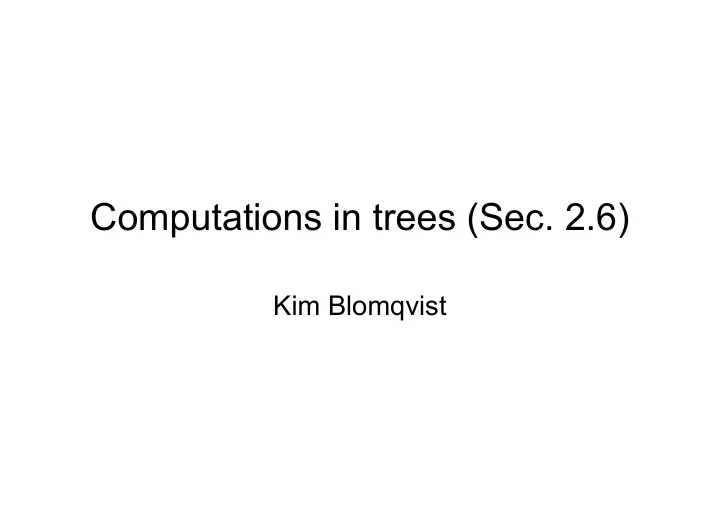

Computations in trees (Sec. 2.6) Kim Blomqvist
Computation in Trees • Restrictions R and knowledge that the network is a tree – every node knows if whether it is a leaf • T[x - y] = sub tree from x with (x,y) removed • d[x, y] = longest distance from x to nodes in T[y - x]
Full Saturation • Works with any number of initiators 1. Activation, starting from initiators activate all nodes 2. Saturation, started by leaf nodes, an unique pair of neighbors is selected. 3. Resolution, started by the selected pair; unique to application - A plug-in algorithm - M[Full Saturation] = 2n + k * -2 - T[Full Saturation] = Max{Min{d(l, y)+t(y)}+d(l,y) ; y ∈ I, l ∈ L}
Minimum Finding • During saturation include smallest known value in M • Resolution is a notification to children started by the two saturated nodes • M[MinF - Tree] = 3n - k * - 4 • T [MinF - Tree] = T[Full Saturation] + Max{d(s, x) : s ∈ Sat, x ∈ V}
Distributed Function Evaluation • Semigroup Operations – f is associative and commutative over all subsets of input values – e.g. min, max, sum, product • Cardinal Statistics – also solvable by Full Saturation – e.g. average, standard deviation
Finding Eccentricities • The eccentricity of a node is the largest distance from a node to any other node. • Trivial for a single node using broadcast and convergecast – M=2(n-1) • Slow to do to all the nodes in a tree
Finding Eccentricities cont. • Using Full Saturation • During resolution: – Send child y (of parent x) the only piece of missing information: • The maximum distance of nodes in T[x-y] • M[Eccentricities] = 3n +k * -4 • T[Eccentricities] = T[MinF - Tree]
Center Finding • Can be done with Eccentricities and an additional saturation and resolution • Theories: – In a tree there is on or two centers (who are neighbors) – In a tree all centers lie on all diametrical paths – node x is a center only if d 1 (x)-d 2 (x) ≤ 1; if strict inequality, then x is the only center
Center Finding cont. • An entity x only needs to know d[x, y] for each of it neighbors y • The Eccentricities provides this information • Same costs • For a plug-in: only move toward the center
Other computations • Finding a median • A median has the smallest average distance to all other nodes – In a tree there is an unique median or a neighboring pair – Entity x is a median iff G[x,y] ≥ 0 for all neighbors y – If x is not the median, there exists a unique neighbor y such that G[y,x]<0; such a neighbor lies on the path to the median • G[x, y] = n + 2 - 2 * | T[y - x] |
Other computations cont. • Finding diametral paths – A node x is on a diametral path iff d 1 (x)+d 2 (x)=d
Rooted Trees • a root is a strong assumption – unsolvable under R • convergecast: simplified saturation • can be totally ordered by a protocol – choosing a random entity possible
Recommend
More recommend